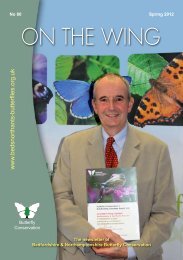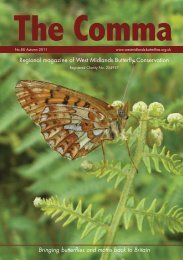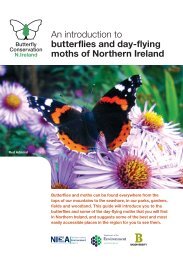EIG newsletter - Butterfly Conservation
EIG newsletter - Butterfly Conservation
EIG newsletter - Butterfly Conservation
You also want an ePaper? Increase the reach of your titles
YUMPU automatically turns print PDFs into web optimized ePapers that Google loves.
Threats<br />
Unfortunately, expansion of such exciting butterflies is mirrored by the decline of<br />
others. The strongest threat concerns abandonment of traditional pastures, hayfields<br />
and forest-steppe.<br />
Forest-steppes once were home to the Danube Clouded Yellow (Colias myrmidone),<br />
a species which is on the verge of extinction, not just in Hungary but globally. Mainly<br />
because of cessation of coppice management and forest pasture, it is an extreme<br />
rarity now. Repeated searches in historical localities in West-Hungary have proved<br />
nothing but its absence during the last years.<br />
Problems in hayfields can be illustrated by declining numbers of several other<br />
European protégées. Dusky and Scarce Large Blues, Marsh Fritillaries and Large<br />
Coppers are not rare yet, because of the commonness of the habitat, but traditional<br />
management disappeared from most of the localities.<br />
Some rare Hungarian species inhabit dry meadows. The Anomalous Blue and Osiris<br />
Blue are species that originate from the Balkans. They need large populations of the<br />
hostplant: Sanfoin, which occurs on dry, unproductive sites. Afforestation and<br />
cessation of grazing are the most important threats.<br />
Opportunities<br />
There is a growing interest in Hungary and neighbouring countries as a destination<br />
for butterfly holidays. The decline of diversity in the West pushes eco tourists to the<br />
East. This is a sad but also a hopeful development, because eco-tourism can be an<br />
eye-opener for local authorities to develop an infrastructure for eco-tourists and<br />
maintain the local natural values.<br />
Eco-volunteer projects could be another tool to emphasize the local natural values<br />
and a very stimulating form of co-operation between East and West. An article in the<br />
recent issue of “<strong>Butterfly</strong>” reported the project performed by a British group in two of<br />
the mentioned habitat types, which are under severe threats.<br />
Nevertheless, regarding the political and economical conditions and the recent<br />
adoption in the EU with its tendency towards (intensive) cultivation of ‘waste’ land,<br />
there is a rapidly growing danger for the destruction of butterfly habitats in Hungary.<br />
In summary, we emphasize the greater then ever necessity for a European minded<br />
approach of <strong>Butterfly</strong> <strong>Conservation</strong>. Not only in a biogeographical sense the West<br />
meets East in Hungary, but we hope that also in terms of butterfly conservation the<br />
West and East will share the same niche.<br />
Rob de Jong and Safian Szabolcs<br />
14







